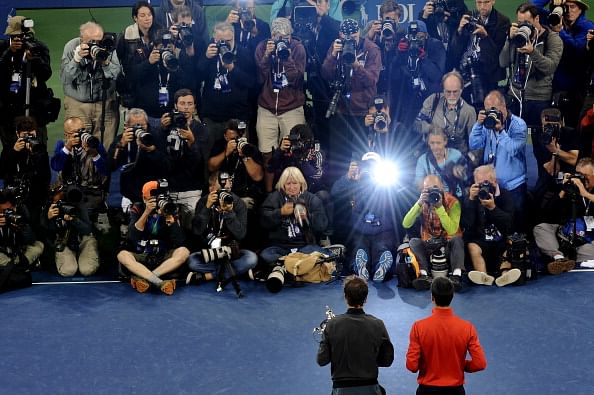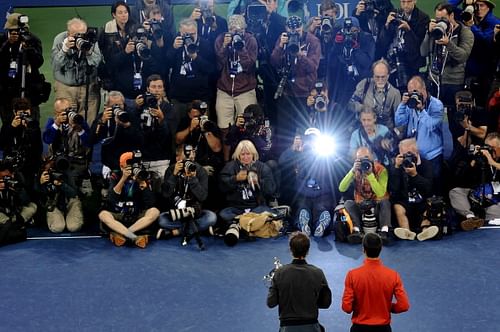
US Open 2013: Telling the tale in numbers - Men's Draw

Photographers take pictures of Rafael Nadal and Novak Djokovic after the men’s singles final at the US Open on September 9, 2013 in New York City. (Getty Images)
The lights are out and the men are on their way home. The curtains have been drawn on the 133rd US Open and the champions have been decorated, while the others have all been paid a handsome wage and sent off the park.
Some went in a hurry, others lingered a little more. And then there were just two men to contest a promising final – one that made up for the lack of drama by weaving a rich tapestry, fitting for the coronation of an unrelenting King.
A lot can obviously get done after a fortnight of frenzied action inside the imposing cauldron called the USTA Billie Jean King National Tennis Center. Rather pompous for a bunch of tennis courts in bustling New York, but trust the Americans to teach you a thing or two about celebrating success.
It takes no less than 127 matches to determine the rightful owner of the glittering silverware and the multi-million dollar payout that goes with it. Obviously there are litanies of numbers that get accumulated as the battling warriors take a bow one after another. So we shall examine some of the key statistics of the just concluded US Open.
Aces do not take you places:
Just ask Milos Raonic, whose 104 aces were 39 more than any other player in the tournament. It is the kind of largely futile accomplishment that must irk its owner, when he is forced to pack his bags after just four matches.
The Canadian lost a five set humdinger to eventual semi-finalist Richard Gasquet 7-6, 6-7, 6-2, 6-7, 5-7. Keeping Raonic company is John Isner, who shot 65 winners in just three matches, before losing to Philipp Kohlschreiber 4-6, 6-3, 5-7, 6-7 in the third round.
Feliciano Lopez and Ivo Karlovic did not last long enough in New York but were fine ambassadors of our hypothesis on aces. Lopez stung his opponents with 51 aces, but then he was eaten up by one of his own ilk. Raonic ousted the Spaniard in a four set match in the third round.
Karlovic fared even worse, rushing out of the tournament in just the second round despite his 50 aces. The giant from Croatia ensured an early swan song for James Blake dishing out a five set thriller before falling to Stanislas Wawrinka in the second round.
Wawrinka made better use of the weapon; 53 aces from his racket helped carry the Swiss all the way to the semis before falling to Novak Djokovic 6-2, 6-7, 6-3, 3-6, 4-6. The Serbian served 48 aces before falling short at the final hurdle.
Gasquet struck 47 aces before falling victim to the ruthless tennis of Rafael Nadal. Incidentally, Nadal was the only man among the semi-finalists, who does not even feature on the list of top twenty ace merchants. And incidentally, he was the last man standing.
First serve is a difficult key:
The men with the highest first serve percentage were once again mostly the men on the run. Nadal and Djokovic are the only men to have played more than three matches, yet retained a spot inside the top 20 first serve percentages.
Gael Monfils brought 83% of his first serves into play but only lasted seven sets and two rounds before falling to Isner, who himself was second on the list. The American brought in 72% of his serves into play, figured on the ace list, yet managed to play just three games.
The key takeaway from a look at the service percentages of Nadal and Djokovic is the importance of combining a good first serve with another weapon in your armoury to make your opponents pay. Nadal at 67% and Djokovic 69% showed remarkable serving consistency through the fortnight to buttress their progress into the finals.
In contrast, the other semi-finalists fared much poorer with their serve forcing them to work harder to remain in contention. Wawrinka only touched 60% once in six matches, living mostly on a first serve rate in the mid-fifties. Gasquet was a tad better with an average in the low 60s, but he too like his Swiss counterpart had to depend mostly on his agility around the court to work his way to the deep end of the tournament.
Attacking the second serve is vital:
Now this is a number that is far more representative of a player’s ability to make an imprint on the tournament. Eight of the top ten players on this list were those who inhabited the quarter-finals.
Djokovic made his opponents pay most often, winning as many as 183 points off the second serve return. Not surprising considering the returning skills of the Serbian and his ability to use the down the line return to devastating effect.
David Ferrer, the consistent Spaniard, was second on the list but he earned 157 points in only five matches. That translates to over 32 points per match on the second serve, far superior compared to Djokovic’s average of under 26 per match.
Gasquet (156), Nadal (147) and Wawrinka (140) round off the top five. It is insightful to find Lleyton Hewitt populating the upper reaches on this list.
The gritty Australian fought tooth and nail for his survival in the tournament, so it isn’t entirely surprising to see him win 127 points off the second serve in just four matches. He was nearly as efficient as Ferrer.